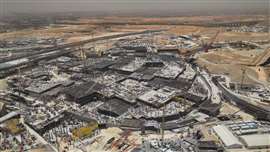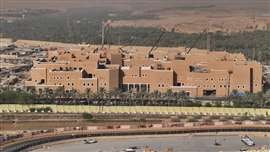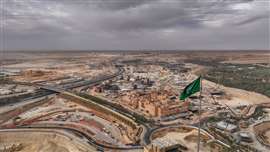Diriyah Megaproject: Saudi Arabia’s US$63 billion vision to transform historic city
11 November 2024
 The size of the whole site at Diriyah is approximately 14km². Image: Diriyah
The size of the whole site at Diriyah is approximately 14km². Image: Diriyah
Across the world there are a multitude of ambitious megaprojects underway but the country currently pushing ahead with the biggest and most ambitious is Saudi Arabia. Out of all its projects, one of the most eye-catching is Diriyah.
 The Saudi government plan to turn the historic city of Diriyah into one of the world’s most visited destinations. Image: Diriyah
The Saudi government plan to turn the historic city of Diriyah into one of the world’s most visited destinations. Image: Diriyah
As the sun begins to set in the desert, it turns the sky behind the Salwa Palace a brilliant shade of orange.
Located in the At-Turaif District in Diriyah, the Salwa Palace was built in 1776 and was the headquarters of the first Saudi state – it is now a UNESCO World Heritage site.
The plan of the Saudi government is to turn this historic city of Diriyah into one of the world’s most-visited destinations for both tourism and business. One of the people playing a key role in the project is Mohamed Saad, President of the Diriyah Development Company, who spoke to Construction Briefing about the project.
Sitting at a desk with pictures of the Saudi Royal family framed on the wall behind him Saad appeared the dictionary definition of calm and composed. This is just as well, given that he is playing a key role in running a project that could cost US$63 billion when completed. The finances are coming from the country’s Public Investment Fund (PIF), the sovereign wealth fund of Saudi Arabia, and the project is part of the country’s 2023 Vision strategy.
“On Diriyah this year we awarded multibillion dollar contracts so far of circa SAU71 billion (US$18.9 billion) of construction contracts already placed. In the pipeline, we have another SAU21 billion (US$5.6 billion). This is only in 2024 – our peak is still coming in the next few years. It is very exciting, very dynamic times and everyone is working really hard,” says Saad.
Peak construction activity
The size of the project is approximately 14 square kilometres but, despite this considerable space, Saad says that due to the sheer number of workers and construction equipment the site is often congested.
“I believe 2025 and 2026 for us would be peak activity on site construction,” he reveals. “Very busy times managing all the contractors, supply chain suppliers and more on a relatively congested site despite the large scale, the area of the project.”
Diriyah has been opening so-called ‘assets’ since 2021 with Bujairi Terrace – which has more than 20 restaurants – opening in 2022 and the project’s first hotel scheduled to open this year. While such a big project necessitates a staggered timeline, there is no doubt that the ultimate deadline is 2030 for the majority of projects to be not only completed but operational.
 Mohamed Saad, President of the Diriyah Development Company. Image: Diriyah.
Mohamed Saad, President of the Diriyah Development Company. Image: Diriyah.
“A project of this size and scale that calls for building hundreds of estates at the same time means you need tens of thousands of workers, tens of thousands of equipment and machines, all in a relatively congested site,” comments Saad. “Logistics become a challenge to manage and orchestrate all these resources on site. It is an exciting challenge, but it’s not an easy problem to solve.
“We are continuously updating and adopting to how we can manoeuvre around the logistical changes. We also realised that there are global factors impacting our supply chain. We are always developing our plans to source our materials and manpower from different parts of the world. The timeline has started, so we need to be very agile in our plans.”
It is envisaged that, when finished, the site will have homes for around 100,000 people, 40 hotels, numerous cultural assets (such as museums, academies and art galleries) five million square feet of retail spaces, more than 1,000 retail and food and beverage outlets and approximately 16 million square feet of commercial office spaces. There will also be four metro stations that will be connected with the country’s wider metro network.
Saad says that construction technology has been key in helping the team keep the project on schedule and also in helping to save money.
“We are investing heavily in digital tools to help us coordinate and manage such a large-scale project. For example, we’re using building information modelling (BIM) for all designers and also for the contractors to do the coordination for the different trades on site using BIM.
“It also helps us as management and as a client to monitor the progress to identify any potential issues and designs. BIM is a very helpful and worthwhile investment. Using it can reduce errors, minimise rework and potentially save up to 20% of our delivery timelines, which are already tight, so we really need to work with smart ways of helping us to navigate through these issues.”
He adds that the use of technology also helps Diriyah with its high sustainability targets – the standard on projects is LEED Gold, which means that a building has excelled in its sustainable design and operation.
International flavour
Contractors from all over the world have worked on Diriyah projects, with China State Construction Engineering Corp recently winning a so-called ‘super package’ to build a US$2 billion urban quarter. Saad references the value of working with Mace as a project management office and the goal of combining the talent of local and global companies.
 Contractors from over the world are working on the numerous assets that make up the project. Image: Diriyah
Contractors from over the world are working on the numerous assets that make up the project. Image: Diriyah
“Diriyah is a global-scale development – we want to work with the best in the world, and we are inviting more and more contractors to come.
“Recently, we gave a contract to UCC Holding from Qatar and Saudi-based Al Bawani joint venture; we always like this mix of local knowledge with international contractors,” says Saad.
Being in the driving seat of such a large project must be very challenging – when there are that many projects ongoing it must be hard, using an old phrase, to see the wood for the trees. It would be easy to be overwhelmed but Saad says what helps him in his everyday work is to imagine in his mind’s eye what the project will look like when completed.
“What I believe helps to boost the energy every day is to visualise 2030,” he reveals. “I think about sitting in the Opera House watching a performance, attending a sports event in the arena or walking the streets and dress square and shopping, dining and seeing families taking their kids for entertainment.”
He adds that while construction technology has helped to bring to life the multiple projects that encompass Diriyah, such as 3D models of the projects and renders, ultimately, nothing will come close to what it will be like when it is completed.
“Nothing will beat the physical experience when it’s delivered,” he says, allowing himself a smile.
MAGAZINE
NEWSLETTER
CONNECT WITH THE TEAM






